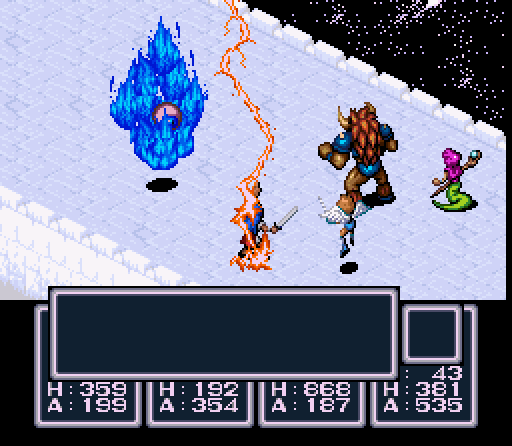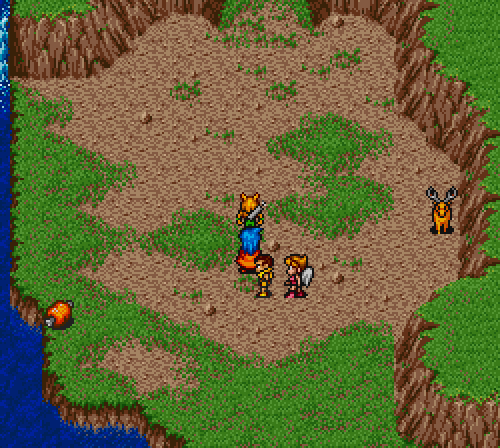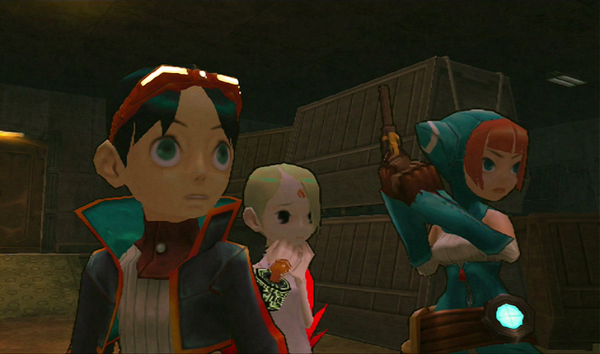
Breath of Fire – Looking back at 25 years
Apr 04, 2018 // Patrick Kulikowski
On April 3, 1993, Capcom released its first flagship RPG, Breath of Fire, for the Super Famicom (Super Nintendo) in Japan. As this series is very near and dear to my heart, I hope you’ll join me in reminiscing about each of the five Breath of Fire games, and what made each so special. Prepare for a tale of dragons, winged bird-people, man-doggos, and…mutated onions!?
Breath of Fire
Available on New 3DS eShop

Released originally on April 3, 1993 for Super Famicom, and later in North America on August 10, 1994 for Super Nintendo, Breath of Fire marked Capcom’s first foray into the RPG genre. It was a great experience fondly remembered for its memorable world.
I talked a heck of a lot already about BoF when it was re-released on the New Nintendo 3DS eShop in 2016. As the first RPG I’ve ever played, my feelings about the series continue to hold true today: 25 years later, it still kicks [dragon] butt!
The first gamestars Ryu, a blue-haired silent protagonist who belongs to the Light Dragon Clan, a peaceful bunch of human-like dwellers who prefer to keep their dragon-morphing abilities in check. When Emperor Zog and the evil Dark Dragon Clan lay waste to Ryu’s village and kidnap his sister, it’s up to Ryu to unleash his dragon transformation abilities, stop the villains from resurrecting a malevolent goddess, and restore peace to the world.
BoF has a lovely, memorable cast of diverse, anthropomorphic characters, each possessing their own unique personality and skill. Each of Ryu’s seven companions plays an essential part in uncovering the world’s secrets. For example, Nina boasted awesome support magic and can (eventually) carry you across the entire world map in bird form, while Bo can traverse the densest of forests and hunt wildlife for sustenance. Karn is a master locksmith that can safeguard your party’s HP from sheer destruction through his trap disarmament skills, and Mogu is able to dig you through just about any situation with his mole claws.

The game’s turn-based battle systemfeatured a neat isometric quarter-view in which characters could slice, stab, sling magic spells, and even transform into supreme beasts to demolish foes. It also had a fascinating mechanic not seen in many games at the time: a day-and-night cycle that would result in different things happening in the world depending on the time of day.
The music of the game is so memorable I could write a whole blog post on that subject alone. Those classic Capcom themes, composed by several members of the Capcom Sound Team and spearheaded by Mega Man 3 / Capcom Jingle composer Yasuaki “Bun Bun” Fujita, are melodically infectious, and I always appreciated how the game’s battle theme and world map themes changed depending on how far you’ve progressed in the game. Speaking of soundtracks, you can actually grab the first three Breath of Fire OSTs from the Capcom Store !
Breath of Fire paved the way for 4 sequels that continued to evolve the series’ tradition of unique storytelling, world and character-building, majestic music, player empowerment, and satisfying combat. 25 years later, it’s still a treat to play through!
Breath of Fire II
Available on New 3DS eShop

Released on December 2, 1994 for Super Famicom, and later in North America on December 10, 1995 for Super Nintendo, Breath of Fire IIis everything a sequel needs and more – featuring upgrades to the visuals, story, combat, environment, and game mechanics.
The game boasts a ton of visual enhancements that complement the gameplay. Magic can now affect your battle environments. For example, Spar’s “Nature” skill can cause surrounding cacti in the desert to explode, dealing additional damage to enemies. An intense fire spell used in a dense forest, on the other hand, causes the backdrop to go up in flames. Characters can also be fused with shamans found all over the world to transform their figures and abilities to give you an added edge in combat.
It’s also easily one of the prettiest sprite-based games on the SNES. There’s an incredible attention to detail, particularly within the game’s battles. Battle backgrounds are massively diverse and intricately detailed; take Mt. Maori’s cavernous walls with slim streams of water seeping down them, for instance. Every character and enemy is smoothly animated, from the intense snarling of a two-headed man-wolf to Katt’s smooth and masterful “twirl-and-smack” staff attack. Throw in some Mega Man X-inspired battle tracks by composer Yuko Takehara and you’ve got some rockin’, exciting battles ahead of you.
The game also solidified the series’ key traditions: BoF1 Ryu and Nina’s ongoing line of same-name descendants, the recurring appearance of the never-aging, sultry half-serpent sorceress Bleu / Deis, a town-building mini-game in which the various town NPCs serve the heroes in useful ways, an incredibly addictive fishing and hunting mini-game, and a plethora of deep-seated themes dealing with death, sacrifice, religion, and the apocalypse. Bring a handkerchief for this one.
Breath of Fire III
Available on PlayStation Store (works on PlayStation Portable, PlayStation Vita, and PlayStation TV)
Breath of Fire IIIwas the series’ first foray into the world of PlayStation. With this jump the series saw a super vibrant 32-bit upgrade and for the first time environments were rendered in 3D.
The game is undoubtedly a fan favorite. It innovated with its dragon “gene” system that allowed players to combine collectible crystals which could transform Ryu into multitudes of varied dragons. Breath of Fire III is full of lovable, complex protagonists (don’t you just want to squeeze Peco, the cutesy mutated onion?), and a deep storyline that features a great mix of humor and morally ambiguous elements. You also have to hand it to Mega Man Battle Network 1 & 2 composers Akari Kaida and Yoshino Aoki for dishing out a vibrant pop / jazz soundtrack – not a typical musical style for RPGs at the time!
For the first time in the series, character statistics and abilities could be dramatically impacted by putting your group under the tutelage of the game’s many “Masters” – special NPCs found throughout the world who teach you special skills you can’t get learn anywhere else. This offered an enhanced level of strategy which in turn would let players get as meticulous as they wanted to about their party’s progression.
Oh, and I still think this game’s fishing minigame is the best I’ve played in any game, period. Even now, the deep bellowing of “GOOD….GREAT!!!” by the fishing minigame’s commentator is permanently etched into my brain.
Breath of Fire IV
Available on PlayStation Store (works on PlayStation 3, PlayStation Portable, PlayStation Vita, and PlayStation TV)
Breath of Fire IV, like a great many Capcom games in the early 2000s, oozes of top-notch design and pristine polish. The series’ detailed art reached new heights to cement its place as one of the prettiest 2D games of the 32-bit generation.
Combat in this game takes a page from BoF1 by allowing players to switch out characters during battle. Players could take advantage of brand-new special attack and spell combos to increase their hit counter and dish out even more damage to unsuspecting enemies, such as Eye Goos.
What especially sets BoFIV apart is its characterization of Ryu and his alter-ego, Fou-Lu, who serves as the game’s villain in the story. For the first time, players got to see the world through the lens of the antagonist, and as you watch the game’s events unfold, you begin to realize that character motivations are not all completely black and white.
The game’s fantastic narrative and phenomenal East-meets-West aesthetic and soundtrack undoubtedly tugged at the heartstrings of many a player.
Breath of Fire: Dragon Quarter

The fifth entry of the series debuted on PlayStation 2 in November 14, 2002 in Japan, and February 16, 2003 in North America. For the first time ever, the series went fully three-dimensional, sporting eye-popping cel-shaded character models.
Breath of Fire: Dragon Quarter introduced a lot of – dare I say – revolutionary concepts to the RPG genre, both story and gameplay wise!
Following the destruction of the surface world following a cataclysmic event, the remaining survivors retreated deep underground. From there, a caste system is formed where people’s worth is measured by a “D-Ratio”; the higher your D-Ratio, the higher your social status. The elite reside much closer to the surface, thereby having access to cleaner air.
Dragon Quarter has a decidedly more dystopian sci-fi look in comparison to the medieval and anime-influenced fantasy style of the previous four games, but the essence of the series is very much here. The music, done by the acclaimed Hitoshi Sakimoto of Final Fantasy XII fame, features a cool marriage of synthesizers and orchestra. Ryu and Nina are still in, but in an interesting twist, Nina is now the silent protagonist whereas Ryu talks.
Ryu can still morph into an intensely powerful dragon, however using it too often causes his Dragon Counter, or “D-Counter”, to increase. This counter increases in various ways as you play, and once it reaches 100%, its game over. However, death is not the end in Dragon Quarter. Players are encouraged to restart the game – because your stored items, weapons, zenny, and party experience points carry over! Combine this with the unique story events, enemy placements, and drops that occur with each subsequent restart, and you get a roguelike RPG way ahead of its time, and for that I wholeheartedly applaud this cult classic.
I like to think of Dragon Quarter as a precursor to other stellar Capcom titles, particularly Dead Rising. Besides sharing a couple of similar members in its production staff, the time limit and story restart mechanics are very much in line with Frank West’s first foray into Williamette Parkview Mall. And like Monster Hunter after it, players could set a number of traps to weaken monsters before slicing, bashing, or firing their way into the fray.
—
The final thing I wanted to touch upon in this celebratory post is the most important, for sure: the fans. Over the years the fans have absolutely rocked it with their support. From cosplay, to music remixes, ridiculously good fan art, and even relay race-style speed runs, you really have to hand it to them for how passionate and awesome they’ve been over the years. Here are some highlights!
Fan Art / Cosplay:
- Breath of Fire II Fanart by Owlboy creator Simon S. Andersen
- Breath of Fire II Nina cosplay by VanityFox
- Breath of Fire II Sten cosplay by ff_saruneko
- Breath of Fire series Fanart by Undertale artist Temmie Chang
- Breath of Fire III Momo fanart by charmwitch
- Breath of Fire III Kaiser Ryu fanart by Iheartpirates
- Breath of Fire IV Ershin x Power Glove Fanart by silentbrains
- Custom Breath of Fire pixel art by Abysswolf
- Breath of Fire: Dragon Quarter Lin cosplay by Rachel Stringer
Music:
- The World is Square – Carnival (Breath of Fire) Folk Cover
- Extra Lives – Breath of Fire – Starting the Journey Rock Cover
- Fhatsk8er – Breath of Fire II “Dying Corpse” Metal Cover
- SmallBu Studio, et. al – Breath of Fire II Soundtrack Cover
- Songe & Marcpapeghin – Breath of Fire III – Fight! cover
- Steven Morris – Breath of Fire III – Can’t You See Clearly Now? (AKA The Farm) Acoustic cover
- Breath of Fire III soundtrack gets jazzed up by Materia Collective
- MaskedBishop – Breath of Fire IV – “Truth and Dreams” Piano Cover
- Sumimi1011 – Breath of Fire V: Dragon Quarter “A Moment’s Joy” Electone Cover
Misc.:
- The Breath of Fire Facebook / Twitter Fan Page Community
- RPG Limit Break – Breath of Fire Series Relay I (2016) & Breath of Fire Series Relay II (2017)
What are some of your favorite memories or moments from this illustrious series? Share them in the comments below, we’d love to hear them! 
-
Brands:
-

Loading...
Platforms:


